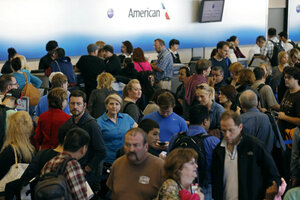Flights begin to resume, after Chicago fire disrupts air travel across nation
More than a thousand flights were canceled from Chicago to Dallas, after a deliberately set fire in an FAA facility near Chicago shut down flights at the nation's busiest airport.

Passengers wait in line at O'Hare International Airport in Chicago on Friday. A fire at an air traffic control center outside Chicago on Friday led to the cancellation of all flights at the city's O'Hare International Airport, one of the world's busiest, and domestic hub Midway, snarling air traffic nationwide ahead of weekend travel.
Jim Young/Reuters
Flights are beginning to resume, after a fire at a Federal Aviation Administration radar center halted almost 1,500 flights in Chicago and across the Midwest, causing delays and cancelled flights across the nation.
The fire in the basement of the FAA facility located outside Chicago in Aurora was deliberately set, the Chicago Tribune reported. An injured contract employee was found at the scene.
Although there had been rumors that the fire might have been set as a terrorist act, police said that they found no evidence supporting that view.
According to the Chicago Department of Aviation, employees at the FAA control center were evacuated around 6 a.m. Friday, after the fire broke out. Shortly after noon, almost 1,500 flights into and out of O'Hare International Airport and the domestic hub Midway had been canceled.
All in-bound flights to Midway were held at their origin until 1 p.m., according to the tracking website flightaware.com.
Meanwhile, the shutdown quickly disrupted travel plans around the country, with airports as close as Milwaukee and as far as Dallas canceling flights. Online radar images showed a gaping hole in the nation's air traffic map over the upper Midwest.
Passengers already in the air who thought they were going to Chicago wound up elsewhere. Some of Southwest's Midway-bound planes returned to their point of origin while others diverted to Indianapolis, Cleveland, Columbus, Louisville, and Pittsburgh, spokeswoman Brandy King said.
Many United flights also turned back. Flight-tracking services showed some Chicago-bound American flights doing loops over Michigan before diverting to Detroit.
O'Hare sees a lot of traffic from United Airlines and American Airlines while Midway serves as a transit hub for Southwest Airlines. Between January and August, more than 580,000 flights departed or landed at O'Hare, the city of Chicago said, citing FAA data.
This incident comes after around 700 flights were canceled at the two Chicago airports in May, after a defective motor in a flight control center in Elgin, Ill., forced staff to evacuate the building once smoke started circulating.
Because both airports are major domestic and international travel hubs – O'Hare is one of the busiest airports in the country – grounded flights have a "cascading effect" on other airports.
"There's cascading delays because nothing can take off bound for Chicago from anywhere," Doug Church, spokesman for the National Air Traffic Controllers Association, told Reuters. "The impact is national and major."
No flights with paths crossing the Midwest were allowed to depart until at least 11 a.m., the Tribune reported.
As shown by pictures circulating on social media, travelers have been forced to wait in long lines to find substitute flights in the wake of cancellations.
- Material from the Associated Press and Reuters was used in this report.

